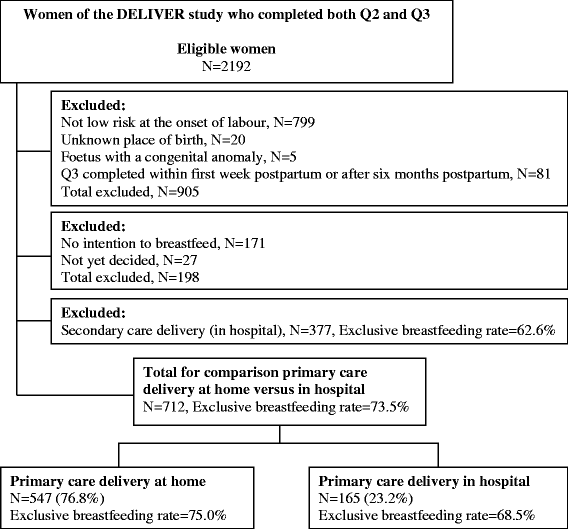Exclusive breastfeeding after home versus hospital birth in primary midwifery care in the Netherlands
- PMID: 26463347
- PMCID: PMC4604719
- DOI: 10.1186/s12884-015-0688-8
Exclusive breastfeeding after home versus hospital birth in primary midwifery care in the Netherlands
Abstract
Background: Breastfeeding has short-term and long-term health benefits for mother and child. We evaluated in what way birthplace was associated with the rate of exclusive breastfeeding among low risk women who gave birth in midwife-led care and who had expressed the intention to breastfeed.
Methods: We used data from the DELIVER study, which includes pregnant women from twenty midwifery practices across the Netherlands between September 2009 and April 2011. We used data from two questionnaires: one in the third trimester (after 34 weeks) and one after the birth (median 39 days postpartum). Only women who indicated an intention to breastfeed were included in the analyses. Multivariable logistic regression analysis was used to assess the association between birthplace and exclusive breastfeeding, adjusted for relevant confounders.
Results: The exclusive breastfeeding rate was 75.0% for the 547 women who gave birth at home, and 68.5% for the 165 women who gave birth in midwife-led care in hospital. The adjusted odds ratio for exclusive breastfeeding after a hospital birth compared to a home birth was 0.79 (95% CI 0.53-1.18). The most frequently reported reason for not breastfeeding at the time of completing the postpartum questionnaire was 'my baby was not drinking enough' (47%).
Conclusions: In the Netherlands, among low risk women who intended to breastfeed their baby, the breastfeeding success rate did not differ significantly between home and midwife-led hospital births. As breastfeeding has short-term and long-term health benefits for mother and child, women should receive adequate lactation support by healthcare workers during the critical postpartum period, regardless of the place where they give birth.
References
Publication types
MeSH terms
LinkOut - more resources
Full Text Sources
Other Literature Sources
Medical
Research Materials
Miscellaneous


